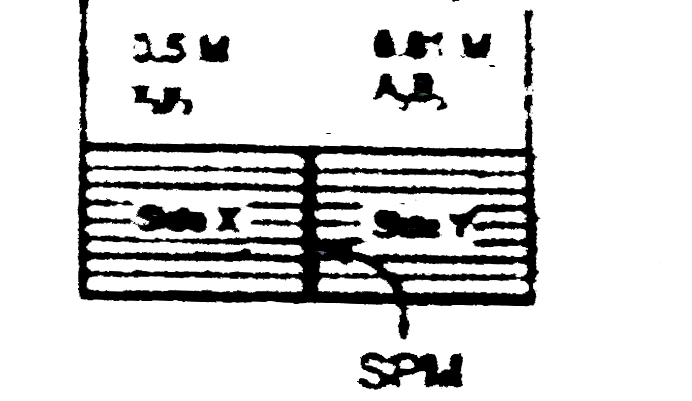When a few typical solutes are separated by a particular selective membrane such as protein particles, blood corpuscles, this process is called:
Transpiration
Endosmosis
Dialysis
Diffusion
The correct Answer is:C
To solve the question regarding the process of separating solutes by a selective membrane, we will analyze each option provided and determine which one fits the description best.
1. Understanding the Question:
The question asks about a process where solutes are separated by a selective membrane, such as protein particles or blood corpuscles.
2. Analyzing Option 1: Transpiration:
- Definition: Transpiration refers to the loss of water vapor from plant leaves.
- Relevance: This process does not involve the separation of solutes through a selective membrane.
- Conclusion: This option is not correct.
3. Analyzing Option 2: Endosmosis:
- Definition: Endosmosis is the process where solvent molecules move into a cell placed in a hypotonic solution, causing the cell to swell.
- Relevance: This process does not involve a selective membrane for separating solutes.
- Conclusion: This option is not correct.
4. Analyzing Option 3: Dialysis:
- Definition: Dialysis is the process of separating particles of colloids from those of crystalloids by diffusion through a permeable membrane.
- Relevance: In dialysis, a selective membrane is used to separate solutes based on their size, which aligns with the question's description.
- Conclusion: This option is correct.
5. Analyzing Option 4: Diffusion:
- Definition: Diffusion is the movement of substances from an area of high concentration to an area of low concentration.
- Relevance: This process does not specifically involve a selective membrane for separating solutes.
- Conclusion: This option is not correct.
6. Final Answer:
Based on the analysis, the correct answer to the question is Option 3: Dialysis.
The question asks about a process where solutes are separated by a selective membrane, such as protein particles or blood corpuscles.
- Definition: Transpiration refers to the loss of water vapor from plant leaves.
- Relevance: This process does not involve the separation of solutes through a selective membrane.
- Conclusion: This option is not correct.
- Definition: Endosmosis is the process where solvent molecules move into a cell placed in a hypotonic solution, causing the cell to swell.
- Relevance: This process does not involve a selective membrane for separating solutes.
- Conclusion: This option is not correct.
- Definition: Dialysis is the process of separating particles of colloids from those of crystalloids by diffusion through a permeable membrane.
- Relevance: In dialysis, a selective membrane is used to separate solutes based on their size, which aligns with the question's description.
- Conclusion: This option is correct.
- Definition: Diffusion is the movement of substances from an area of high concentration to an area of low concentration.
- Relevance: This process does not specifically involve a selective membrane for separating solutes.
- Conclusion: This option is not correct.
Based on the analysis, the correct answer to the question is Option 3: Dialysis.
Topper's Solved these Questions
- SURFACE CHEMISTRY BOOK - AAKASH INSTITUTE ENGLISHCHAPTER - SURFACE CHEMISTRY EXERCISE - Assignment Section - C (Assertion - Reason type questions)
10 Videos
- SURFACE CHEMISTRY BOOK - AAKASH INSTITUTE ENGLISHCHAPTER - SURFACE CHEMISTRY EXERCISE - Assignment Section - B (Previous year questions)
14 Videos
- STRUCTURE OF ATOM BOOK - AAKASH INSTITUTE ENGLISHCHAPTER - STRUCTURE OF ATOM EXERCISE - ASSIGNMENT ( SECTION -J) Aakash Challengers Questions
12 Videos
- TEST 1BOOK - AAKASH INSTITUTE ENGLISHCHAPTER - TEST 1EXERCISE - EXAMPLE
134 Videos
Similar Questions
(A) Each trophic level, a certain mass of living material at a particular time and as …….P……….
(B)Breakdown of detritus into smaller particles , this process is called ………Q……….
Fill in the blanks with suitable word.
View SolutionWhen a cell expends energy to move a solute across its membrane against a concentration gradient, this process is called ………..
View Solution
Knowledge Check
When transport proteins simultaneously move two molecules across a membrane in the same direction ,the process is called
AuniportBantiportCsymportDdiffusive port.In passive transport across a membrane, when two protein molecules move in opposite direction it is called as
AuniportBantiportCsymportDco-port.Assertion: When a solution is separated from the pure solvent by a semi-permeable membrane, the solvent molecules pass through it from pure solvent side to the solution side.
Reason: Diffusion of solvent occurs from a region of high concentration solution to a region of low concentration solution.AIf both assertion and reason are true and reason is the correct explanation of assertion.BIf both assertion and reason are true, but reason is not the correct explanation of assertion.CIf assertion is true, but reason is false.DIf both assertion and reason are false
When a solution is separated from a solvent by a semi-permeable membrane, then the phenomenon taking place is called as
View SolutionThe process used in separating large particles from smaller ones in a solution is called
View SolutionX3Y2(i=5) when reacted with A2B3(i=5 in aqueous solution gives brown colour. These are separated by a semipermeable membrane AB as shown. Due to oxmosis there is :

a.brown colour formation in side X
b.brown colour formation in side Y
c.formation in both of the sides X and Y
d.no brown colour formation
View SolutionThe process of separation and purification of expressed protein before marketing is called
View SolutionThe process of separation and purification of expressed protein before marketing is called
View Solution
